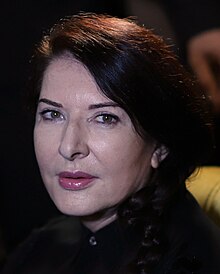Marina Abramović e Ulay - MoMA 2010
https://www.youtube.com/watch?v=OS0Tg0IjCp4
Marina Abramović | |
|---|---|
Марина Абрамовић | |
 Marina Abramović – The Cleaner at Palazzo Strozzi in Florence, Italy, in September 2018 | |
| Born | November 30, 1946 |
| Education | |
| Known for | |
Notable work |
|
| Movement | Conceptual art |
| Spouse(s) | |
| Website | mai |
Marina Abramović (Serbian Cyrillic: Марина Абрамовић, pronounced [marǐːna abrǎːmoʋitɕ]; born November 30, 1946) is a Serbian conceptual and performance artist, philanthropist,[1] writer, and filmmaker.[2] Her work explores body art, endurance art and feminist art, the relationship between the performer and audience, the limits of the body, and the possibilities of the mind.[3] Being active for over four decades, Abramović refers to herself as the "grandmother of performance art".[4] She pioneered a new notion of identity by bringing in the participation of observers, focusing on "confronting pain, blood, and physical limits of the body".[5] In 2007, she founded the Marina Abramović Institute (MAI), a non-profit foundation for performance art.[6][7]

沒有留言:
張貼留言